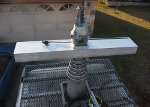|
Though LMR-400 is great, you are aware that at 2412MHz it has an attenuation loss of 6.6dB/100ft? This means that a 70-ft cable run (after adjusting for insertion loss) would cost you ~5.2dB loss? And then on top of that you are going to build your own antenna (which for microwave has to be pretty precise)? Let's do the math (Assuming Linksys...Adjust accordingly for Ubiquity (600mw--> 27.8dBm & -95dB RX sensitivity))...
Assuming Linksys:
Pout=0.079W --> 18.9dBm
Linksys Pout (assuming no di/duplexer) & cable run --> 18.9dBm - 5.2dB = 13.7dB of power to antenna
Assuming you can have an antenna gain of 8dB we yield an ERP of 21.7dB. Sounds good eh?
So let's assume you have another node 300ft away, Let's calculate the Free Space Loss:
L=32.4+20*log(D)+20*log(f) = 32.4+20*log(300/5280*1.609km)+20*log(2412MHz) = 79.2dB loss per 300ft path
So at a receiving antenna, the antenna sees a signal that is 21.7-79.2 = -57.5dB.
Now, let's look at the Linksys hardware...The Linksys device at the other end has a RX sensitivity that is around -65dB.
Assuming the antenna has no gain and the cable in the other Linksys device has no loss...
Now we compare the numbers...difference between the two is (-57.5)-(-65)=7.5dB margin.
This 7.5dB margin will likely work fine in fair weather, but it may not be enough to protect the link from extreme weather conditions.
A margin of 10 to 15dB is fine. However, to give for some attenuation and multipath in the received radio signal, a margin of 20dB should be safe.
That's only half of it...Now we need to look at the RX signal that the Linksys device attached to 70-ft LMR-400 cables receives. (Same equations...I'll just post the sequential numerical results).
18.9dB --> (antenna) --> -79.2dB --> Antenna RX sig of -60.3 --> 8dB Antenna Gain: -52.3 --> Feedline loss: -57.5dB --> Margin: 7.5dB.
(I wasn't expecting it to be the same...) So the same result applies. Link will be intermittent. Note: Amplifiers are nice, but keep in mind that they also amplify any noise that they receive and introduce it into the signal and into the device. You are better off with a nice antenna and a very short cable run (60-70ft is not short).
For link planning...Consult chapter 10 of the Wireless Networking in the Developing World. I mean this post in good terms...plan out your link accordingly and think it out in detail before you do anything.
|
